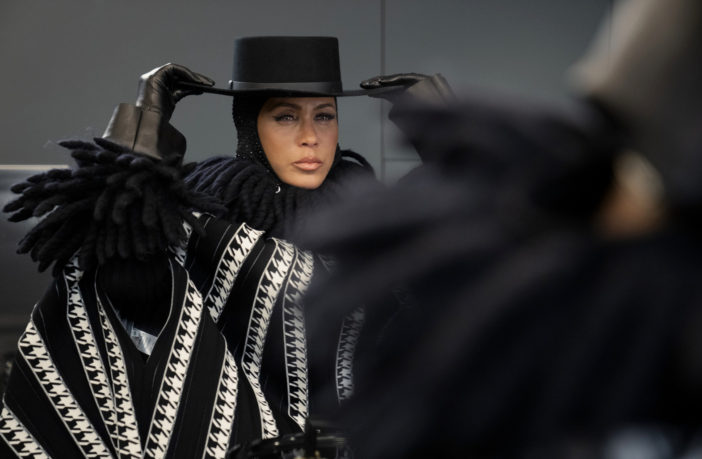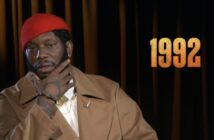The latest episode of And Just Like That gives us more insight into the life of Lisa Todd Wexley (LTW), the Upper East Side filmmaker, wife and mother played by Nicole Ari Parker. Nothing will stop this creative from getting to a special event about her latest film project, not even Mother Nature. That determination takes viewers on a journey inside Lisa’s closet and showcases how Black women can transform for the occasion under any circumstance.
“Look for pictures of sculptors Elizabeth Catlett and Edmonia Lewis, the first internationally famous Black female sculpting artist; Constance Baker Motley, the first Black female federal judge who was part of the team that argued Brown Vs. Board of Education; and Portrait of Madeleine, the famous painting of a Black woman in the Louvre by Marie-Guillemine Benoist,” declares series writer and consulting producer Susan Fales Hill, who was instrumental in curating the vision of Lisa’s envious dressing space.
“There’s also Tomiko Brown-Nagin’s biography of Constance Baker Motley—Lisa and Herbert got busy in front of it—and last but certainly not least, a photograph of the iconic Diahann Carroll, my mother’s best friend and the embodiment of glamour, intelligence and humor.”
If every attention to detail seems to be just in place for LTW, it’s because Fales-Hill’s life pretty much parallels the character. She attended the Lycée Francais de New York and graduated with honors from Harvard College before pursuing her writing and production career. She serves on the boards of St. Paul’s School in Concord, New Hampshire, as well as of American Ballet Theatre. and is on the International Best Dressed List Hall of Fame. “I have a highly curated collection of shoes, handbags, suits and evening gowns,” she reveals to EBONY. “I consider dressing well my moral and cultural duty. When and where I enter, the whole race enters with me, so I better look good!”
Fales-Hill reveals more about bringing LTW’s life to light on the series and why it was about darn time the show reflected New York City’s multiethnic landscape.
Susan Falles-Hill. Image:
Bryan Bedder for GettyImages.
EBONY: How does your own fabulous life parallel and inspire the Wexleys’ world?
Superficially, like the Wexleys, my family and I live on the Upper East Side and our daughter attended private school. Though I don’t have LTW’s fabulous art collection, my parents were multilingual and I grew up speaking French and Italian at home. Little Gabby reciting the French poem in episode one was drawn directly from my life, and my daughter’s. I learned that poem, Jean de La Fontaine’s La Cigale et la Fourmi, at school at 8 years old and so did my daughter, Bristol. On a deeper level, I’ve been married for 26 years with all of the ups and downs, joys and sorrows that that implies. And Like the Wexleys, my husband comes from a more straight-laced family than mine. LTW’s father, played by the legendary Billy Dee Williams is an homage to all the brilliant, elegant and politically engaged Black artistic men I grew up around: Roscoe Lee Browne, Harry Belafonte, Gordon Parks, Arthur Mitchell, Derek Walcott and Sidney Poitier.
Why was it so important to bring characters of color into this incarnation of the SATC franchise?
It was important to bring characters of color onto the show to accurately reflect New York’s multicultural reality. New York is not an Alabama country club in 1952. You have to work very hard in this town to lead a “monoethnic” life, especially if you are actively engaged in business and the city’s civic and cultural activities. The characters in this series would organically meet in their places of work, their children’s schools, their social circles, the museums, galleries, the theaters they frequent and on the boards on which they serve.
What are some of the main points you wanted to come across when writing and consulting on the show?
I think it’s vital to show America’s best-kept secret: the Black bourgeoisie. We have not often been centered on film and television, and that’s not an accident. Since the days of Reconstruction minstrelsy, there’s been a conscious and then later an unconscious effort to marginalize Black people from mainstream economic activity and depict us as unworthy and incapable of anything above domestic work or criminality. Educated and successful Black people have historically been as threatening to the status quo as any gun-toting revolutionary. The brainwashing has been so effective that we ourselves accuse those working in corporate jobs of not “keeping it real,” as though Blackness were innately incompatible with traditional “success.” This show offered a unique opportunity to show a breadth of Black characters maintaining their cultural integrity while thriving in banking, fashion, film, and education at the Ivy League level, like Nya, played magnificently by Karen Pittman. She represents so many Black female legal eagles from New York University’s Melissa Murray and Harvard Law School’s Tomiko Brown-Nagin to former NAACP Legal Defense Fund head Sherrilynn Ifill and Danielle R. Holley, the Dean of the Howard Law School. Similarly, New York is full of LTWs: highly educated, socially active, driven women who can also rock a Chanel.
The LTW character is actually based on a real mover and shaker in New York City.
Lawyer turned filmmaker Crystal McCrary was the original inspiration, but LTW stands “for 10,000.” And it’s a joy to depict a man like Herbert Wexley, her husband, incredibly played by Tony nominee Chris Jackson. He represents so many accomplished Black men who strive every day to pave the way for others not only in the workplace but also at the ballot box and in our nation’s corridors of power, like former Amex CEO Ken Chenault, former Merck CEO Ken Frazier, top attorney Ted Wells and investment banker/Crystal McCrary’s husband Ray McGuire, just to name a few. These people exist—they have historically,—and they are staking a claim on the “American Dream” for all of us. It’s a joy to tip my hat to them through And Just Like That’s sugared pill of comedy. This is what I’ve always done in my television writing, beginning with A Different World, where I served as executive producer and head writer.
Sex and the City has always been an inspirational blueprint for women. How does it inspire women of color, especially those in their fifties?
I grew up around ageless Black women and to me, LTW and Nya are homages to their brilliance, beauty and humor. My mother, Josephine Premice, and the other “fairy divas” who graced our home like Cicely Tyson, Carmen De Lavallade, Eartha Kitt, Diana Sands, Maya Angelou and Lena Horne, never took themselves too seriously and always made it clear that, as Toni Morrison put it, “Race is a distraction'” you shouldn’t let it keep you from focusing singlemindedly on your gifts and goals. These women lived by the motto, “Don’t let the world define you. You show the world who you are.” And as my mother would always say, “Don’t let any man give you wrinkles or tell you ‘you look so beautiful stirring the soup.'” In other words, stay away from men who want to demoralize you or just stick you in the kitchen! LTW and Nya embody that philosophy in all that they do.
Watch And Just Like That on MAX.



